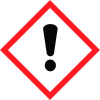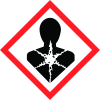Carbon tetrachloride
Sigma-Aldrich
Revision date : 2013-01-10



Note: Ingredients listed on restricted chemical lists
EC/CAS
56-23-5
Name of the chemical
Carbon tetrachloride
Concentration
N/A
EC/CAS
200-262-8
Name of the chemical
Carbon tetrachloride (CTC)
Concentration
N/A
General Information
Revision date
2013-01-10
Product name
Carbon tetrachloride
CAS No.
56-23-5
Supplier name
Sigma-Aldrich
Emergency telephone
Americas Region
Icons in SDS
Company Information
Company name
Sigma-Aldrich
GHS Information
Signal word
Danger
Hazard Codes
Hazard statements (CLP)
H301+H311+H331, H316, H320, H351, H372, H412, H420
Hazard statements
Code
Statements
H301+H311+H331
Toxic if swallowed, in contact with skin or if inhaled
H316
Causes mild skin irritation
H320
Causes eye irritation
H351
Suspected of causing cancer
H372
Causes damage to organs through prolonged or repeated exposure
H412
Harmful to aquatic life with long lasting effects
H420
Harms public health and the environment by destroying ozone in the upper atmosphere
Precautionary statements
Code
Statements
P261
Avoid breathing dust/fume/gas/mist/vapors/spray.
P273
Avoid release to the environment.
P280
Wear protective gloves/protective clothing/eye protection/face protection.
P301+P310
IF SWALLOWED: Immediately call a POISON CENTER/doctor/...
P305+P351+P338
IF IN EYES: Rinse cautiously with water for several minutes. Remove contact lenses if present and easy to do - continue rinsing.
P311
Call a POISON CENTER or doctor/...
Section 2
SECTION 2: Hazards identification
NFPA Rating Emergency Overview
2.3 Other hazards
Carcinogen, Target Organ Effect, Toxic by inhalation., Toxic by ingestion, Toxic by skin absorption Target Organs Liver, Kidney, Eyes, Nerves., Heart
Other hazards which do not result in classification
Rapidly absorbed through skin.
2.1 Classification of the substance or mixture
Acute toxicity, Oral (Category 3) Acute toxicity, Inhalation (Category 3) Acute toxicity, Dermal (Category 3) Skin irritation (Category 3) Eye irritation (Category 2B) Carcinogenicity (Category 2) Specific target organ toxicity - repeated exposure (Category 1) Acute aquatic toxicity (Category 3) Chronic aquatic toxicity (Category 3) Hazardous to the ozone layer (Category 1)
Signal word
Danger
Hazard statements
H301 + H311 + H331 Toxic if swallowed, in contact with skin or if inhaled H316 Causes mild skin irritation. H320 Causes eye irritation. H351 Suspected of causing cancer. H372 Causes damage to organs through prolonged or repeated exposure. H412 Harmful to aquatic life with long lasting effects. H420 Harms public health and the environment by destroying ozone in the upperatmosphere
Precautionary statements
P261 Avoid breathing dust/ fume/ gas/ mist/ vapours/ spray. P273 Avoid release to the environment. P280 Wear protective gloves/ protective clothing. P301 + P310 IF SWALLOWED: Immediately call a POISON CENTER or doctor/ physician. P305 + P351 + P338 IF IN EYES: Rinse cautiously with water for several minutes. Remove contact lenses, if present and easy to do. Continue rinsing. P311 Call a POISON CENTER or doctor/ physician.
Health hazards
2 * Flammability: 0 2 Fire: 0 Reactivity Hazard: 0
Physical hazards
0
Potential health effects
Inhalation Toxic if inhaled. May cause respiratory tract irritation. Skin Toxic if absorbed through skin. May cause skin irritation. Eyes May cause eye irritation. Ingestion Toxic if swallowed.

